SOIL HEALTH SERIES
SOIL – We walk on it; we grow things in it. But do we really understand and appreciate the magnificent living ecosystem below our feet? Healthy soil is essential to all life and over the next 12 weeks we will explore soil’s many hidden secrets!
Posters of the following soil topics are included as .pdf documents at the bottom of this page.
- Soil or Dirt?
- What is soil texture?
- What's your soil's texture?
- Soil matters
- Soil horizons
- Soil pH
- Interesting soil facts
- Soil nutrients
- Soil food web
- Ways to improve soil
SOIL or DIRT?
To the naked eye, SOIL and DIRT look virtually the same. But in reality, the two are vastly different!
Soil
Soil is quite literally bursting with LIFE! It’s made up of multiple ecosystems of microorganisms, insects, and arthropods; an ecosystem that creates an extensive food web that provides nutrients the fuel needed to sustain a dynamic symbiotic ecosystem that supports plants, animals and humans.
insects, and arthropods; an ecosystem that creates an extensive food web that provides nutrients the fuel needed to sustain a dynamic symbiotic ecosystem that supports plants, animals and humans.
Soil is created when mountain stones and bedrock are broken down by wind and rain over centuries. Leaves, plants, grasses, small bugs, and animals fall into the cracks of rocks and when these organisms start breaking down, soil begins to form.
Dirt
When soil is cut off from its ecosystem it dies and becomes dirt. Dirt is comprised of sand, clay, silt, rocks, pebbles, and some organic matter, but is void of any life (beneficial microbes and nutrients).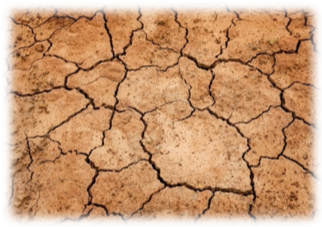 Because dirt does not have a set structure, it will not become compact when moisture is added.
Because dirt does not have a set structure, it will not become compact when moisture is added.
Dirt is dead soil and cannot support life. It can, however, get onto clothes and under the fingernails.
Source: soils.org
WHAT IS SOIL TEXTURE?
Soil texture is a measurement of the minerals in your soil -- those ground up bits of rock which are pulverized by erosion into small particles over thousands of years. Soil texture is determined by the PROPORTIONS of sand, silt and clay particles in your soil.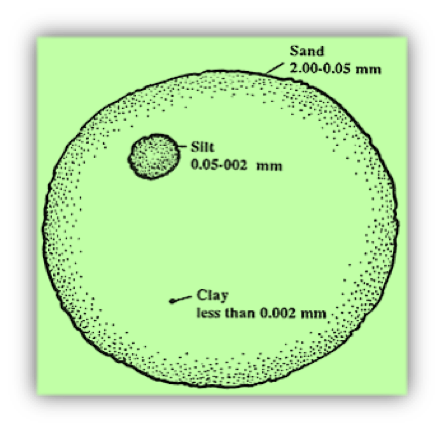
- SAND … The gritty bits. Each grain is about the size of the head of a pin or less.
- SILT… Smooth and soft like cornstarch. Silt particles are about the diameter of
a human hair. - CLAY … Sticky when wet. Each bit is microscopic, about the size of a bacteria.
Soil texture has an ENORMOUS effect on soil’s water retention ability and on nutrient availability.
CLAY and SILTY soils hold more water and nutrients, but are easily compacted.
SANDY soils drain freely and resist compaction, but nutrients are easily leached from the soil.
Gardeners’ dream of LOAM, an ideal soil in which the mineral content consists of about 40 percent sand, 40 percent silt and 20 percent clay.
An ideal SOIL would be made up of 45 percent minerals (sand, clay, silt), five percent organic matter (plant and animal), 25 percent air and 25 percent water.
Sources:
https://www.sciencedirect.com/topics/earth-and-planetary-sciences/soil-texture https://agriculture.canada.ca/en/agriculture-and-environment/soil-and-land/soil-and-water/soil-texture-and-water-quality
WHAT’S YOUR SOIL’S TEXTURE?
Estimate the texture of your soil with a SIMPLE HOME TEST!
- Remove organic debris (sticks and leaves) from one cup of soil and place the soil into a
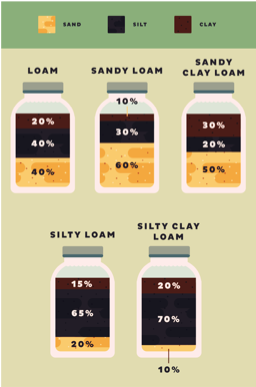 one-litre mason jar.
one-litre mason jar. - Add water to within four centimetres of the top of the jar.
- Add one drop of liquid detergent and shake vigorously for one to two minutes.
- Allow jar to sit undisturbed for 24 hours.
Course particles (SAND) will settle first, with SILT and CLAY layers settling out later. The resulting layers can be measured to estimate the relative amounts of each. By comparing these numbers to a soil triangle (below), soil texture can be estimated.

ANOTHER WAY to estimate texture is the finger test:
Simply rub a small amount of wet soil between your fingers. You will be able to distinguish between a predominantly sandy soil (gritty), a silty soil (silky but not sticky) and a clay soil (smooth and sticky).
Sources:
Chalker-Scott, L. Soil Myth Busting for Extension Educators: Reviewing the Literature on Soil Structure and Functionality.
Research Gate. Canadian Soil Texture Triangle.
https://www.researchgate.net/figure/Canadian-soil- texture-triangle-that-uses-only-two-axes-to-determine-soil-texture-from_fig3_50917086
SOIL MATTERS
WITHOUT SOIL, HUMAN LIFE WOULD NOT EXIST





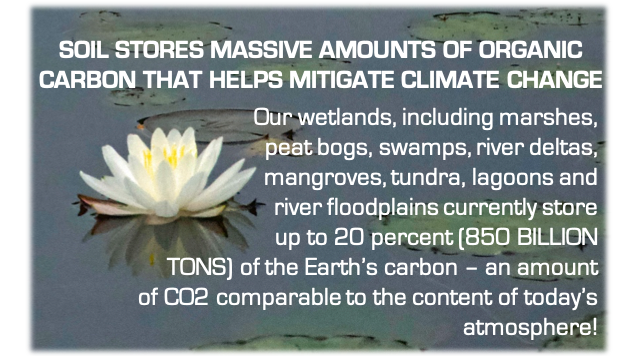
Sources:
https://www.soils.org/files/science-policy/sssa-marketing-2013.pdf
https://www.isric.org/discover/about-soils/why-are-soils-important
https://extension.umaine.edu/gardening/manual/soils/soil-and-plant-nutrition/
SOIL HORIZONS
The layers of soil underfoot have developed over eras of glaciation, erosion, flooding and a thousand other circumstances. You’ve likely heard a lot about topsoil and bedrock, but what about the layers in between? 
Soil layers run parallel to the soil surface and are called HORIZONS. Their physical, biological and chemical characteristics differ from the layers above and beneath.
Topsoil (O and A Horizons)
- Uppermost 5-10 inches of soil
- O Horizon is where we find plant litter
- Contains highest concentration of organic matter and microorganisms
- Most plant roots are found in topsoil
- Dark colour
Subsoil (B Horizon)
- Where many minerals accumulate
- Commonly reddish-brown due to iron content
- Often has a distinctly different soil structure than the horizons above
- Most garden plant roots infiltrate this layer
Substratum (C Horizon)
 Consists of partially weathered rocks that have not yet been affected by the conditions that created the layers above
Consists of partially weathered rocks that have not yet been affected by the conditions that created the layers above- Contains calcium carbonate & other soluble minerals
- Tends to be a lighter colour than the layers above
Bedrock (R Horizon)
- Unlike C horizon’s rocks and boulders, the bedrock layer is a massive layer of rock that makes up more of what we consider the earth’s crust
Sources:
www.nrcs.usda.gov
www.ctahr.hawaii.edu
SOIL pH
WHAT IS SOIL pH? It’s a measure of the ACIDITY or ALKALINITY (hydrogen ion concentration) of the soil. It’s largely determined by the rocks and minerals, and the weather that occurred when the soils were created over thousands of years!
Soil pH is IMPORTANT! It determines the availability of soluble plant nutrients and the microbial activity of the soil.
- pH below 5.5 – low availability of calcium, magnesium, and phosphorus.

- pH 7.8 or higher – calcium and magnesium abundant, BUT high pH soils may have an inadequate availability of iron, manganese, copper, zinc, and (especially) phosphorus and boron.
- A pH of 6.6 to 7.3 is most favourable for microbial activities that contribute to the availability of nitrogen, sulfur, and phosphorus in soils.
How to tell if a plant isn’t suited to the pH of the soil?
- Chlorosis (yellowing of leaves); .Stunted growth; Curling leaves.
- The nutrients the plant is lacking MAY BE PRESENT IN THE SOIL in relatively large amounts BUT not available due to the unfavourable pH.
How to determine the pH of your garden soil?
- The BEST way is to have a LABORATORY test your soil for you. BUT there are inexpensive home kits (widely available and easy to use) that will give you a reasonable estimate of your soil’s pH level.

Can I change the pH of my soil?
- IT DEPENDS! Acidic soils can be successfully amended by the addition of ground limestone, BUT the soils in the KAMLOOPS AREA are generally NOT ACIDIC.
- Elemental sulfur can be added to alkaline soil, eventually forming an acid and lowering the soil pH.
- Fertilizers like crushed sulfur and some ammonium-based nitrogen fertilizers lower pH and make soil more acid. BUT, over-use of fertilizer can contaminate ground water and run-off into lakes and streams!
- Canadian sphagnum peatmoss can help to TEMPORARILY lower the pH but peat moss is a limited resource and should be used sparingly.
- The BEST way to amend your soil and create a pH buffer for plants is to add ORGANIC MATTER to the soil.
- Compost and green manures help to bring soils closer to a neutral pH; provide lots of nutrients, and keep the microbial populations HAPPY!
Sources:
BC Ministry of Agriculture. Soil FACTSHEETS: Acidifying Soils; Soil pH, 2015.
Robert, John, Whitlock, Turner. GeoTour Guide for Kamloops British Columbia. Natural Resources Canada, 2017.
www.qld.gov.au/environment/land/management/soil/soil-properties/ph-levels
INTERESTING SOIL FACT
- 500 TO 1,000 years to form one inch of topsoil.
- Only 1% of the microorganisms in soil have been identified so far.
- Soils are home to 25% of all animals living on the planet.
- Glossy magazine pages contain about 70% soil.
- 1 MILLION earthworms in one acre of crop land.
- 2500 GIGATONS of carbon is stored in the world’s soils – that’s more carbon than the atmosphere and all plant life. combined!
- HALF of the world’s topsoil has been lost during the last 150 years.
- Less than 10% of the earth’s land is suitable for agriculture.
Sources:
Confer, S. Fascinating Soil Facts: 23 amazing facts about soil. . Nomomente.org 2021 news.climate.columbia.edu
nrsc.usda.gov
soils.org
SOIL NUTRIENTS
Nutrients reach the soil in many different ways: from decomposed animal waste and dead plants, the atmosphere, weathering of rocks, and bacteria conversions.
To complete their life cycle, plants need ESSENTIAL NUTRIENTS, each in varying degrees.
- CARBON, OXYGEN and HYDROGEN are essential to plant growth and are supplied by air and water.
- The other essential elements are referred to as mineral nutrients and enter plants almost exclusively through the roots. These nutrients are divided into two groups.
- MACRONUTRIENTS (primary/secondary nutrients) are required by plants in larger amounts and include nitrogen, phosphorus, potassium, calcium, magnesium and sulfur.
- MICRONUTRIENTS (trace elements) are tiny amounts of nutrients that include iron, chlorine, manganese, boron, zinc, copper, and molybdenum.
- ALL MACRO/MICRO nutrients are critical to normal plant growth and development; they are simply needed in different amounts.
- IF growing conditions are good, a plant will absorb nutrients from the soil.
- IF a plant experiences extremes in temperature, incorrect light levels, or water- logged or compacted soil, it will have a limited ability to absorb nutrients (*plants in dormant stages absorb few nutrients).
Sources:
North Carolina State Extension. North Carolina State Extension Gardener Handbook. Soils & Plant Nutrients,
https://content.ces.ncsu.edu/extension-gardener-handbook/1-soils-and-plant-nutrients
SOIL FOOD WEB
 In a spoonful of garden soil there are BILLIONS of different living organisms – INDUSTRIOUS ORGANISMS that make your soil a better place for plants to grow.
In a spoonful of garden soil there are BILLIONS of different living organisms – INDUSTRIOUS ORGANISMS that make your soil a better place for plants to grow.
As organisms consume other organisms, nutrients convert from one form to another and are made available to plants (grass, trees, shrubs, agricultural crops) and other soil organisms. They improve soil structure and increase nutrient retention, among many other things.
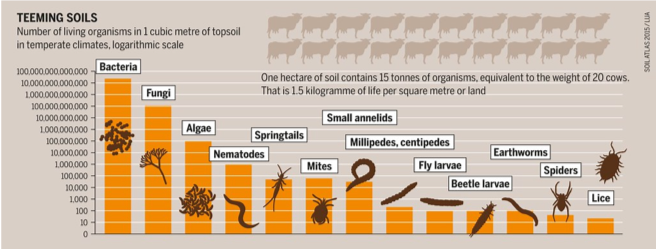
The organic contents of soil must be REPLENISHED CONSTANTLY as plants consume soil elements and pass them up the food chain.
Sources:
Heinrich-Böll-StiftungBartz/Stockmar, Wikimedia Commons
nrsc.org
WAYS TO IMPROVE SOIL
Soil is a finite resource - here are a few things you can do to conserve our soil
Feed your soil with organic matter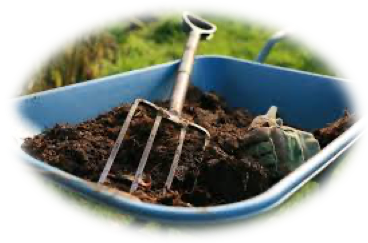
- Layer on top – do not dig in
- Compost; leaves; mushroom manure; aged/dried animal manure; humus
- Fall is a good time to add organic matter because it will decompose over the winter
Protect your soil with organic mulching
- Organic mulches help retain soil moisture; moderate seasonal temperature extremes; lessen weed growth; add nutrients; retain rainwater and mild runoff.
Avoid soil compaction – tread with care
- Soil compaction leads to poor water infiltration, runoff, erosion, and ponding in your
 garden. It results from too much foot traffic, use of heavy equipment and other heavy loads, especially when the soil is wet or saturated.
garden. It results from too much foot traffic, use of heavy equipment and other heavy loads, especially when the soil is wet or saturated. - WAIT until garden soil is relatively DRY in the spring before digging, planting, and stepping on it.
Conduct a soil test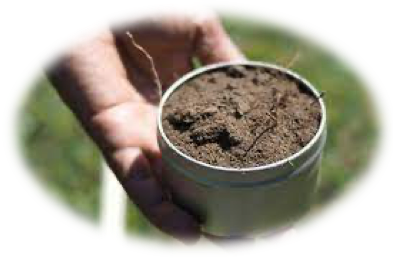
A balance of available nutrients is essential for optimal plant growth. The only way to know for sure is to conduct a soil test.
Avoid pesticide use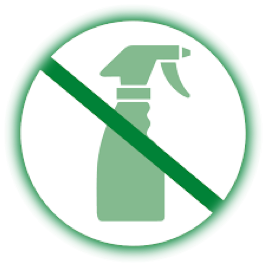
- Well-tended gardens don’t typically need pesticides. It’s NORMAL to see insects on outdoor garden plants and most do no or little damage. For most pests, a COUNTERPART BENEFICIAL INSECT is looking to gobble it!
- Spraying pesticides needlessly can KILL beneficial insects, including pollinators.
Source:
https://extension.psu.edu/practical-tips-for-healthy-soil-in-a-home-garden
| Attachment | Size |
|---|---|
| 1 SOIL or DIRT?.pdf | 464.8 KB |
| 2 WHAT IS SOIL TEXTURE?.pdf | 513.79 KB |
| 3 WHAT'S YOUR SOIL'S TEXTURE?.pdf | 399.2 KB |
| 4 SOIL MATTERS.pdf | 214.34 KB |
| 5 SOIL HORIZONS.pdf | 479.3 KB |
| 6 SOIL Ph.pdf | 407.38 KB |
| 7 INTERESTING SOIL FACTS.pdf | 191.61 KB |
| 8 SOIL NUTRIENTS_0.pdf | 415.42 KB |
| 9 SOIL FOOD WEB.pdf | 117.71 KB |
| 10 HOW TO IMPROVE SOIL.pdf | 7.07 MB |